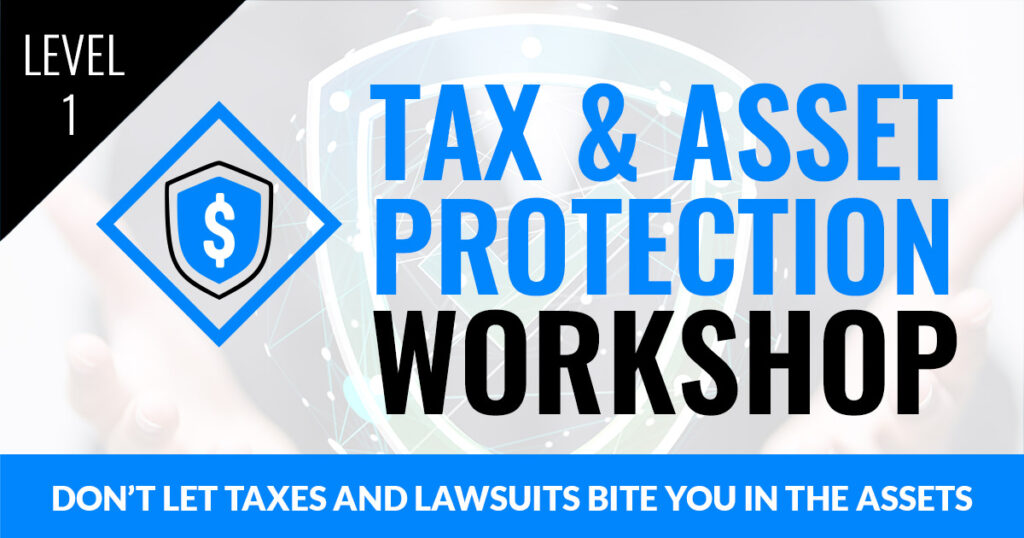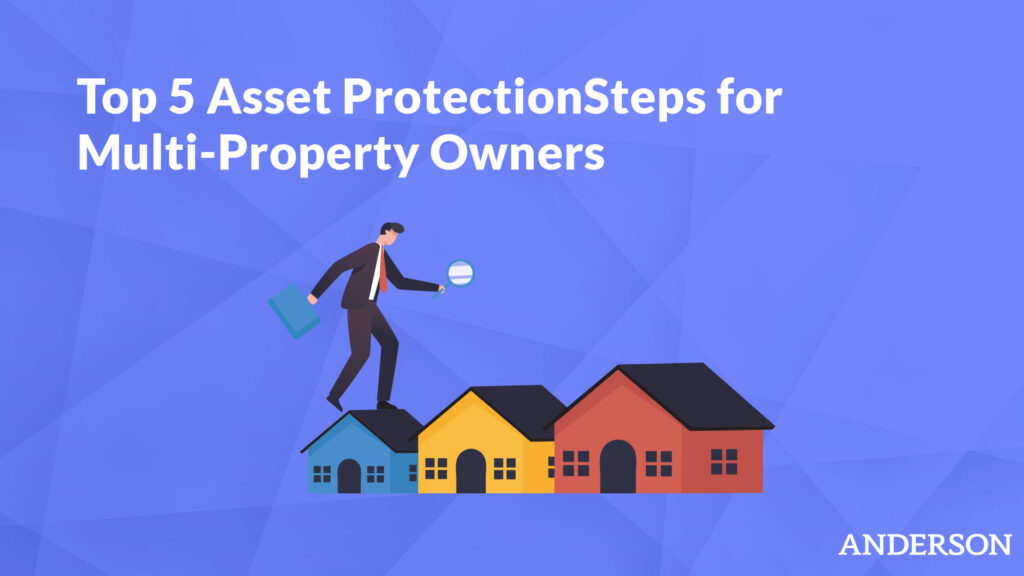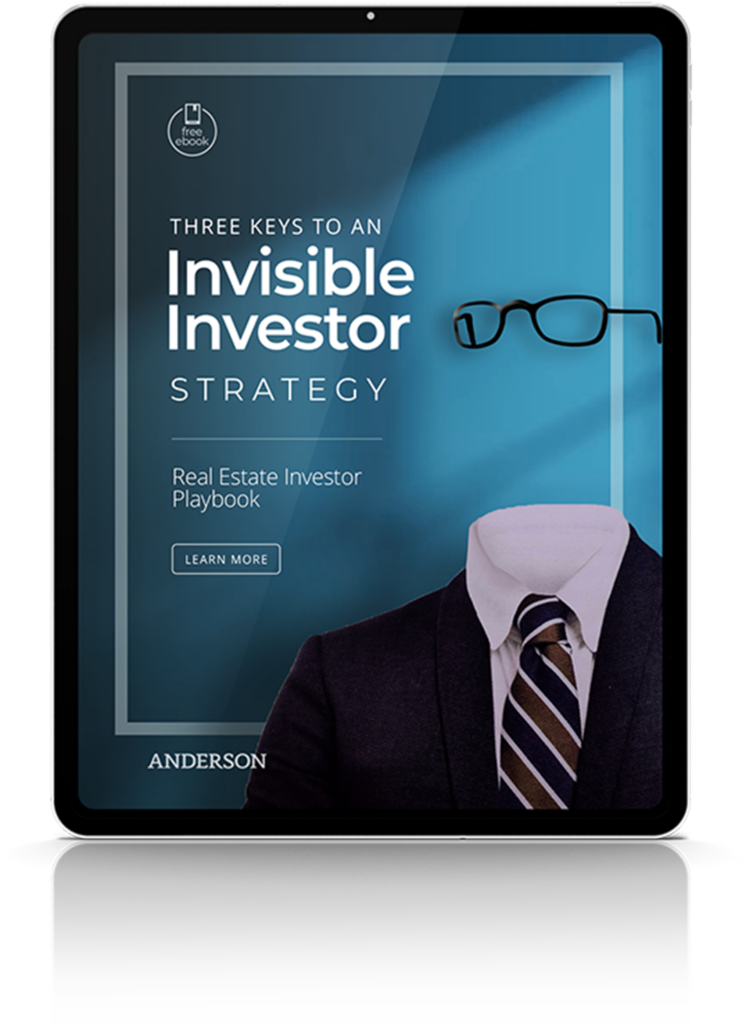
How do you get started in real estate investing outside of your local area? Are you struggling to get started in a different state? Trying to figure out how to find properties outside the area in which you live?
Today, Clint Coons of Anderson Business Advisors talks to Gary Beasley, Co-founder and CEO of Roofstock, a leading real estate investment marketplace. Gary explains how to start investing in real estate that is not in your local area, but in markets where you get higher cap rates and properties without having to put in hundreds of thousands of dollars.
Gary has spent most of his career building businesses in the real estate, hospitality, and technology sectors. Before starting Roofstock, Gary led one of the largest single-family rental platforms in the United States through its IPO as Co-CEO of Starwood Waypoint Residential Trust, now part of Invitation Homes.
Highlights/Topics:
- Numbers Game: Sizable portfolio with multiple properties for multiple cash flow streams
- Roofstock: Unlocks asset class for investors to break down geographic barriers
- Result: Real estate investors buy homes with tenants to create efficient marketplace
- Differences between Roofstock, Redfin, and Zillow when it comes to property research
- Risk-Reward: What returns will be generated and what risks are you willing to take?
- Where to get properties? Organically, customer acquisition, PR, educational content
- Rent Ledger: Access data in the system and view tenant payment history
- Best of Both Worlds: Opportunity to buy it now and all returns are based on that price
- Roofstock Academy: Sign up and get proprietary access to experts who help you
- Different Sellers, Motivations. Some want to sell quickly, and some are more patient
Resources:
The Remote Real Estate Investor
Full Episode Transcript:
Clint: Hey, what’s up guys? In this episode, what I want to talk about is investing outside of your local area. You’ve heard me talking about real estate investing, now we’re at 250 properties, and I get questions all the time. In the comments on the videos they ask me, Clint, how did you get started in a different state? We’re struggling trying to figure out how to find properties outside the area in which I live. I get it, that is a challenge, and it’s really hard for many investors to figure that piece out.
Well, there’s someone that I’ve been following for quite some time now, watching them grow this company and what they can do for real estate investors. Finally, I was able to secure them, get them to come on here, and share with you how you can start investing in real estate not in your local area, but in those markets where you’re getting higher cap rates and you’re being able to get into properties as well without having to shell out $300,000, $400,000, or 700,000. As you know, I talk about it as a numbers game, trying to build up a sizable real estate portfolio of having multiple properties for multiple streams of cash flow coming in over time.
The best person to explain that, I have found, is Gary Beasley. He is not only the co-founder, but he’s also the CEO of roofstock.com. Gary, thanks for coming on.
Gary: Great to see you, Clint.
Clint: Hey, you know what? You’ve got such an impressive background, the tech side. Could you maybe share some of that with people so they understand how Roofstock came about and where you’ve come from to create this?
Gary: Sure. So I’ve spent most of my career, I would say, at the intersection of real estate and technology. I did traditional real estate early in my career. I spent a fair amount of time in the hospitality industry. Did resort investing and then ran a boutique hotel company for a while. And then my first foray into really a tech-oriented model was a company called ZipRealty that was really amongst the first to put real estate listings online, complete MLS online back in the early 2000s.
I was CFO of that business. We took it public in 2004 and ended up having about 2000 agents that were employees of the company initially being out there providing service to real estate buyers, not investors. These were typically people buying just to live in the homes, but I saw the power of using the internet to distribute information, make agents more efficient. So that was kind of my first residential-driven model.
A little bit later in my career, most recently, got involved about a decade ago buying houses during the great financial crisis. So I really started buying homes in about 2009, 2010 with some partners. We ended up building a pretty decent business around it. So we turned it from just an investment opportunity, even cheap houses with guild into an actual enterprise. And we actually took that public as a REIT, as a real estate investment trust, back in 2014. That was called Starwood Waypoint Residential Trust.
It’s now part of Invitation Homes, which is the largest single family rental platform that’s public. They currently own about 84,000 homes, and so my old company is part of that company.
So my background has really been as an entrepreneur in real estate looking for ways to apply technology and new business processes to interesting real estate opportunities. I like to look for macro trends and work on building companies that could take advantage of that. Really, the last decade or so, I’ve really been focused on the single family rental asset class, which up until a decade ago was entirely mom and pop-driven, folks like you and I just buying homes individually over the last decade.
There was now about 2% of the market, maybe 2.5% that’s owned by the big institutional investors, call it 400,000 homes, out of the 20 million rental homes that are out there. So it’s still very much owned and controlled by individual investors, but historically has been very hard, as you point out correctly, to invest where you don’t live. And really, the genesis of Roofstock with my co-founders and I really got the idea that we should help unlock this asset class for investors, break down the geographic barriers, set it up so you could buy homes with tenants already in place rather than having to buy vacant homes off the MLS, and create a marketplace that allows for that to happen very efficiently.
Importantly, we cater to both large institutional clients. We’re selling hundreds or thousands of homes at a time down to individuals, a lot of individuals who are looking to buy or sell a single home or even a share of a home, which we can talk about. We’re trying to really make the asset class accessible. So for me personally, starting Rootstock was a life goal really to start a company from scratch. I joined a number of companies early, had never been a founder per se, and so we founded Rootstock in 2015. It’s been a great professional and personal experience and very satisfying because it happens to be in an industry I have a real passion for.
Clint: Yeah. I’ve been through your site and I mean, when I started looking I was like, wow, there’s so much information here for a real estate investor. If you’re trying to find property outside of your geographical location, I mean, this would be the go-to just because of the amount of information you provide. I know you have cap rates, you have what it would rent for if you wanted to do that type of analysis, and you have all these tools that you build into it. That makes it phenomenal, but at its bare essence, how would you describe it for a real estate investor? Why would they want to come to roofstock.com? What are they going to get out of it?
Gary: I guess the simplest way I would describe it is it’s almost like Amazon for houses, right? You could come onto our site and shop for houses almost like you’re shopping for shoes. It’s not quite that simple. But you can put in your search criteria and see homes not just in a particular market, but homes all over the country that meet the parameters that you’re looking for.
What we try to do is—using our digital infrastructure and our field operations—make it very easy for investors, not just to buy homes in an hour’s drive around where they live, which is what’s typical so people can sort of feel like they know the market and oversee the management. We break down those barriers and allow you to see properties all over the country. We have a bunch of research you can see about markets and really allow you to have almost the country as your oyster as opposed to just where you live.
Our technology and our relationships around the country enable that, and I think allow people to then become much more diversified in their exposure and really rely on a lot of the third-party infrastructure that we can provide to execute.
Clint: Okay, so when I first jumped on your site, the thing that came to mind when I was looking at it was, well, what’s the difference between this and Redfin or Zillow when it comes to research and property?
Gary: Sure. So think about those sites generally as content providers. Zillow in particular, you go there and it’s content. I think when you think about online real estate 1.0 was about content, real estate 2.0 is more about commerce. What we are is really, I like to describe us as sort of a FinTech-enabled marketplace, so all the products and services around that transaction we can provide in an integrated fashion. We’re a soup to nuts platform that you could actually transact on digitally.
When you go to Zillow, you see a lot of good information, but then you just get connected to a real estate agent. If you’re interested in a bunch of different houses, you’re having to call a bunch of different real estate agents. And especially if you’re looking at properties where you don’t live, you don’t have all of that information that you have on Roofstock. That’s how I would describe the differences.
We are real estate investors at our core. We know what real estate investors need to see to transact because we bought thousands of homes ourselves through our prior platforms, and we simply created a product that we think would be really useful for investors. Understanding it’s really about what returns are you going to generate over time and what risks are you willing to take. When a lot of platforms I think where they stopped short is providing enough data and information so investors can really understand the risk-reward of different investments.
We have a neighborhood scoring algorithm, for example, that rates neighborhoods one to five stars. That takes into account about a dozen variables and those get updated over time. How can we try to make that remote investor feel as local as possible? While it’s a digital transaction, a lot of the data that we generate and make available to people is gathered locally. So it is, in that sense, a bit hybrid because you can’t just make this up.
It’s not a purely financial product. There’s a tangible asset, and you really have to understand what’s going on in the local market, and so we try to really ingest as much of that local data as we can and also partner with local people in the field to make sure we’re creating almost a local experience but in a remote way.
Clint: Because that’s always the fear I think for people investing out of state is that they’re going to end up buying a property, it’s going to be in the hood, and they got to collect rent with a shotgun, assuming they’re even going to get paid. And not knowing is I think what holds a lot of investors back. You guys have done a tremendous job when I was going through the site and looking at the amount of information you provide so that, like you said, the neighborhood or the schools, what they’re like in that area and whether or not the people are employed. How many of them are homeowners versus renters?
The data that you should be analyzing, you don’t know where to find it. You guys have aggregated all together. But here’s something that struck me and piqued an answer, I mean, I know you can answer it, where are you getting these properties from?
Gary: The majority of our properties, people come to us organically. We do some online customer acquisition so we could reach out to folks. We do a fair amount of PR and we have a lot of educational content where people come to learn about Roofstock. It’s not just a place where you come to buy properties, but also a place you could sell your properties.
One of the fundamental value props of Roofstock, as we were thinking about launching it, was, yeah, it’s great to buy a home with a tenant in place, but it’s even better to be able to sell one with a tenant in place. Because to sell it today old school, if you have a rental home, you have to wait for the lease to expire, you fix it up a little bit to put it on the MLS. You pay a broker five to six points, and it takes you a few months to close the transaction between the time you vacate it and you find a buyer and sell it.
When you add up all those costs, including the carrying costs while you’re getting zero rent, it’s about 10 to 12%. The alternative is with Roofstock, if you have a rental home with a tenant in it, you can come to us, we can certify and list the home on our site. We charge typically 2.5 to 3% to sell the home and that’s it. You sell the home with a tenant in place. There’s no downtime. Investors are coming to our site and want to buy it with a tenant in place so you don’t have that additional CapEx or downtime.
Then investors oftentimes can close faster than homeowners. We have cash buyers at our site. We have people who need financing sometimes, but clearly, when you look at all of that from a disruption standpoint, it’s a lot easier to sell through us. It’s not only cheaper, it might be a lot lower cost, but it’s also easier.
Clint: Okay. So when I was looking at the site and I was going through a lot of the properties, you provided the data on the tenant, the income, and how long they’ve been there. How do we know that that is solid? I mean, what do you guys do to verify it? If I’m a seller and I’m throwing a property, yeah, I’ve got a tenant, I’m collecting $1200 a month. I mean, I can tell you anything.
Gary: Yeah, we verify the rent ledger. We have a whole process so when we look at the tenant payment history, we’ll actually make sure that we want to see the bank statements or if it’s a property manager, and a lot of these homes are already professionally property managed, it’s very easy that data is in the system and we can see it.
We’re not just taking the word of the seller, that’s part of the advantage of our platform. We’re diligence-ing this property as if we were buying it and we just expose all that information for everyone to see. It’s important, right? If a seller were to do that and they were to misrepresent something, they would be banned from our site and we would go and make sure we’re making things right for the buyer.
So we actually have a different approach than many marketplaces. We have a 30-day money back guarantee on our site for retail buyers. So if you buy a home on Roofstock and somehow you’re unhappy like something just doesn’t seem right or I just have cold feet, you can actually come to us and say, you know what, I made a mistake. I want to get out of this.
What we’ll do is we’ll resell the home for free and we have to sell it for less, we’ll make you whole on that. We’ll cover the difference. Now, it doesn’t happen very often, but occasionally, things will happen and we’ll do that.
But we realized when we were starting Roofstock, no one had ever created a marketplace where you’re buying $100,000, $200,000, or $300,000 items site unseen. Some good advice that I heard from one of our early investors, Marc Benioff, who founded Salesforce. He talked a lot in the early days about building trust.
If you’re going to build a marketplace you have to build trust. Okay, well, how do you build trust? It’s a little bit like when you buy an airline ticket and you know you could return it or things like that, so we did the same thing with our marketplace for houses because you’re not going to be able to fly, see it, and inspect it. So we wanted to create this feeling of trust, and it also held our feet to the fire. So hey, we’re going to put our money where our mouth is. We want to make sure that what we’re presenting on the site is solid.
Clint: Okay. When I’m looking at the site, I find an area that I want to invest in, and I see there’s a number of properties there. Let’s say the property is listed at $78,500, is that negotiable? Do I get contact with the seller and I can make an offer as, hey, I’ll give you $72,465?
Gary: Yeah. So when we first started the site we didn’t allow that. It was just a Buy It Now price because the thinking was we wanted to be more like a marketplace where you could see what is there and remove the need to negotiate. And then we were working with sellers to try to list it at a price that they were happy selling.
What we realized was that wasn’t working as well because real estate investors typically like to negotiate a little bit, as you know. So we did two things. We introduced an open house concept where for the first 72 hours, a seller can do price discovery. Let’s say, my tentative list price is $150,000. During that time, you could go in and you could either bid that amount, you could bid more, or you could bid less. The seller sees that information and based on that may actually hit one of the bids or may adjust their listing price based on what the market’s telling them it’s worth.
After that 72 hours, the seller decides whether they want to accept an offer or list it at their suggested price, higher, or lower. Hits the market, let’s say, I was trying to list it for $150,000 and I got a bunch of bids that were lower, I might list it for $145,000. Then you can go in as a buyer and immediately buy it at $145,000 because that’s a Buy It Now price or you could say, I’ll offer you $138,000, and then you can go back and forth with the owner and negotiate through the platform.
It’s kind of the best of both worlds. There’s an opportunity to buy it now at a price, and all the returns that are on the site are based on that price, plus all the other expenses that are involved in the closing and all that kind of stuff. What you could do is you could type in different amounts or move the slider and see how much your returns change. A lot of people are trying to get to a certain yield or a certain IRR. They’ll say, okay, based on this, I can offer this amount and then they will make the offer.
We try to make it such that it’s quite interactive, and most people do end up offering a little bit below listing price. It’s usually in the 2 to 3% below the listing price where things tend to trade on the marketplace. But sometimes, in competitive markets, homes will hit the market and they’ll trade exactly at their offer price because people have been monitoring this, it works at that number, and because there’s such little inventory sometimes they’ll trade right away.
Clint: Wow. With those homes, you can buy the single families, like you said, or one-off home properties. But one of the things I realized when I first started investing outside the state of Washington, is I’d pick up these onesies, twosies here and there, and it just didn’t really work for me overall because I didn’t develop enough core property, especially with property managers. What I found is that if I had one property with a property manager, if my property needs to be rented but the guy who has 20 properties had two vacancies, typically, that guy’s properties would get filled—
Gary: That guy might get the most attention, yeah.
Clint: So what I thought was so interesting about your site is you actually offer packages as well, so you can do a 5-pack, 4-pack, or 10-pack. You have investors that are bringing that to the table as well. Maybe you could speak a little bit about how that works.
Gary: Again, I think it’s kind of the best of both worlds because you could buy a 5-pack or a 10-pack, or you buy a single home, but the beauty of it is if you select one of the property managers who we’ve negotiated service level agreements with—in each market, we certify local property managers. We have our own, which is called Great Jones for Retail Property Management, which we bought last year, which is a great alternative.
We’re a little bit like Progressive Insurance, you could use ours or you could use others and we’ll show you other good property managers. We’ve negotiated good pricing and service standards, so if you pick any of those, we have scale operations with them. So even if you own a single home, they might manage 100 homes for Roofstock clients in that market. You’re getting the attention as if you’re almost a larger portfolio owner, even though you just own one of them. So you kind of get the benefit of scale while you’re still small. That’s, I think, one of the cool things about the way we’ve approached property management.
Clint: So that is one of the top three fears that I hear in investors in investing out of state, who’s going to manage my property? They’ve heard of it. I dealt with it. I had a property manager in Indiana. He never paid me a dime, and after eight months, I went out there to find out what was going on. I kept getting the runaround. He’d actually died three months earlier. When I went to the house where I knew he resided, his kids answered the door, they slammed it in my face, they had the property rented, and they’ve been stealing money from me for eight months. I mean, again, that was one of the first deals I bought.
I get it, this is a fear that people have. What you guys have done is you’ve gotten and you’ve nailed it. If I’m a property manager and I want to have access to your investors, the people that are buying, on your site, I’m going to take care of your people because then, I would assume, you’ll boot them.
Gary: We will. Rarely but we’ve had to do it. And we also monitor customer ratings and want to make sure that they’re just generally doing a good job and our people are happy. If they’re not doing a good job, we will boot them off the site and we’ll replace them with another property manager who will. Because we end up giving them a lot of business, it’s a good carrot. We have a little bit of a carrot and stick approach.
Clint: Great. What really interests me too is that one of the benefits for real estate investors, especially physicians, people that are bringing in high income, is that if you set yourself up the right way, you can depreciate your property, especially right now with bonus depreciation and cost segregation, you’re able to wipe out a lot of income that you may generate in a given year, active income, with the right type of […].
At the end of 2021 last year, this past year, we helped a physician. He had sold a clinic, he had a million dollars in gain, he bought some properties, and he was treating the short term rentals. We went in and almost wiped out all of his taxable income for the entire 2021 by how we were able to structure them. What real estate investors are starting to realize is that short term rentals only produce great cash flow, but it’s different than being a real estate professional in order to capture deductions.
It’s so much easier. You just have to put in 100 hours, 7 days or less, and then you can take advantage of cost segregation, bonus depreciation, and offset it against your active income. So when I was looking at your site and because people always say, well, how do I know if that property I buy is eligible for short term rentals? You guys did it. I saw that right there, short term rentals.
If I was an investor and I see this because I push a lot of clients. I say, you want to look for short term rentals. Are you guys going into the markets and then determining what all the regulations are and then saying, yeah, this fits in that category?
Gary: Yeah, we just launched a short term rental site a few weeks ago, which you saw, and that was really based on feedback from our customers who said, guys, we love the long term rental play, but we’d love to have a property work that we could use, for example, and have some utilization component, have it rented out, and fully managed for us. We’re constantly testing things. Some people raised their hand and our product team and our ops team said we’ll stand something up. So we launched it in kind of a lightweight way and the response has been really, really good so we’re now leaning into it.
What we’re doing is our initial partner is Mi Casa. They’re the largest short term rental manager. They’re interested because they could potentially continue to manage homes that otherwise the owners are looking to sell. We’re able to present it more to people who are looking at the investment characteristics of the short term rental rather than just posting the home on the multiple listing service and people having to run their own numbers and figuring out if it’s a good rental or not.
We can get inventory that they help us provide. We can scour the MLS and really find homes that are for sale that work really well as short term rentals because we get the data, we do all the analytics, and then we could say, okay, this home is vacant today, but we run it through all the analytics to make sure and check all the local regs to make sure it’s able to be rented on a short term basis, and we present it that way. Then you could figure out how many days you might want to use it and we’ll show you how many days we think it could be rented out otherwise, run the numbers. Then you can buy it through our site.
Yeah, I think it’s in the very early days of investors really getting excited about short term rentals, but I do think, over the next few years, you’re going to see a lot more interest in that category. More and more professional management companies are emerging, and more and more people are able to spend time remotely in nice places. You might want to spend a month or two in Montana and then have it rented out on a short term basis when you’re not there, so you’ve got these digital nomads and all this kind of stuff.
There’s just so much more mobility. Why not be able to buy a property, carry it, and maybe make some nice positives? Some of the yields on these short term rentals are even higher than the long term rentals. Sometimes people just want to use it and just break even, and that’s great, or carry cover most of their costs. Other times people are saying, I want a high yield and I’m not really going to use it. It’s a pure investment. We see the whole spectrum.
Clint: So if I was first coming to your site, what do you recommend I should do?
Gary: Well, I think it depends on if you’re a novice or you’re an experienced investor. So if you’re just getting started, I would encourage you to check out our blog and a lot of our content. We have a podcast called The Remote Real Estate Investor. It’s becoming increasingly popular for people who want to learn about remote investing. We have a lot of good content on our blog and research on our site, so I would say come in and try to start to educate yourself. Poke around. The site is designed to be explored, so go in, start looking at properties, start looking at areas. Play with some assumptions and also think about what your goals are.
We obviously have people you can engage with as well who work at the company, but I think it’s good to initially just poke around a little bit and see what kind of properties meet your objectives. You could search based on various criteria. Don’t be afraid to look at places you’re unfamiliar with because I think one of the things that people often do is, as we talked about earlier, just focus where they live, but be open-minded.
Say if I’m looking at markets with certain characteristics or homes with certain characteristics, put in those parameters and you’ll start to see things that you might not have thought about. We have a lot of people who have been buying homes in markets like Birmingham, Alabama or places like that that they’ve never really thought about, and then they started putting in these are the things that I’m looking for in a market and all of a sudden, you see these great homes in a market you knew nothing about.
Then you could go do some research on Birmingham or some of these other places and say, wow, that’s not a bad place to invest some capital. It’s uncorrelated to where I live or things like that. Really use it to explore and learn. I think that’s one of the great things about real estate investing. There are so many different strategies to pursue. The markets are dynamic. They’re all over the country. You don’t have the same market dynamics going on, so you can go and learn.
If you’re a more experienced investor, you could use this site and use some of the more robust tools that a novice investor might not ever unlock. But if you really understand single family rentals, you might want to open up the detailed analytics and play with assumptions because you know what your operating expenses have been in a certain area. We make estimates on things based on what we know about the markets, but you may have a different approach.
You could go in there and really use all of our tools. So really, what we’ve tried to do is design the site so it works for everybody. If you want a pretty lightweight experience, a lot of the things are served up for you. But if you want to dig down deep and really control the knobs a little bit, you can do that too.
Clint: And you have a great education platform as well that people can take part in and learn.
Gary: Yeah, the Roofstock Academy. Yeah, that’s been very popular. You could sign up and you get proprietary access to experts who can help you think through your strategy, some proprietary content, some tools, and things like that. So yeah, that’s another great avenue.
Clint: Yeah, it’s really good. So you talk about markets, where do you think the market’s going?
Gary: It’s so fascinating. If we had three hours we’d be scratching the surface plan, as you know, right? Here’s a very high level view that I have. Last year, prices went up close to 20% nationally for homes. Over the long term, that number has been, if you look over the last 50 years, 4%, right? It’s kind of a plus or minus. It’s typically inflation plus a bit and.
So will it be 19% again this year? No, I don’t think there’s any case for that. I think you’re seeing the home price appreciation rate going down slowly. You’re seeing interest rates are going to be creeping up as rates go up, it puts pressure on home prices. So I think this year, we’ll see home price appreciation in the single digits, not 15 or 20%. I still think it’ll be higher than the long term average, but it’ll be less than 10%. I don’t know what that’s going to be nationally, but 7 to 8% if I had to guess, working down. I think it’s healthy. You can’t have multiple years of 15 or 20% home price appreciation.
Now, that being said, the counter to that is supply is not keeping up with demand. We’re at record low levels of inventory, and that’s putting a lot of pressure on prices when things are trading, but we’re seeing some signs. I think inventory is going to start creeping up. You overlay a global pandemic and all these other economic factors that are happening, it’s really hard to say exactly how it plays out. I’m still long term bullish on the asset class. Just from a macro standpoint, it’s really hard to keep up with the demand for houses because it’s hard to build at-scale homes.
It’s a lot easier to build apartments, and apartments and homes are not perfect substitutes. I think you’ll see housing continuing to be strong. Obviously, markets vary. But that’s my overall view of what’s going to happen this year, absent some sort of black swan event that no one can predict, right? But I think if things progress as they look like they’re progressing with the Fed, if we have relative, I think what you’ll see, I don’t want to call it a soft landing necessarily, but I think that’s what we’re going to see to some degree with housing when it comes to home prices.
Clint: What do you see with the days on market on properties that you have on your site?
Gary: The homes that sell on our site tend to sell pretty quickly. The majority sell within about two weeks of being posted, the majority of homes that trade, so it is a bit of a tale of two cities. If it’s a home that is priced appropriately, it trades very quickly. Sometimes, sellers will still choose to price 10% above the market or something because they might not be in a hurry to sell, and then they will wait to see offers and maybe they’ll slowly lower their prices. Those might be on 30, 45, or 60 days because they’re not in a hurry to sell.
The beauty of selling a rental property is they’re still getting paid to wait. So if you have a home, this is one of the challenges that, let’s say, Zillow had with their home selling business is they’re buying vacant homes, and every day that was costing them real money. When you have a rental home that’s generating cash flow, you can be patient and sell into the market, and that’s okay. Different sellers have different motivations. Some still want to sell quickly and some are going to be more patient.
We have a pretty high level of liquidity in the marketplace in general because it’s also investors coming in. Once they know what they want, especially after you’ve made a few offers or maybe bought a few houses, when something hits your feed that meets your criteria, you feel empowered to move quickly. We make it easier and easier the more once you buy that first or second property. We have a lot of people who are coming back because they’re serial buyers now adding to their portfolio, maybe get a bonus at work, or they want to buy a home every year or two, so really putting people on a program to build out that portfolio over time that they’re looking to build.
Clint: You said something key there, which I’m glad you mentioned, is that feat. I mean, the best part about it is you’re going to know when the properties that you’re searching for when somebody lists one for sale you’re going to find out about it, so you’ll be able to jump on that right away.
Gary: That’s right. It’s interesting, when we tested, we do put some of the homes on our site, as I mentioned in the short term rental conversation, our long term rentals that are simply homes listed on the MLS that local agents who we work with as local partners identify using our tools as good rental homes, and we’ll list those on our site, so you could buy them. That’s an interesting way where we bring in that local expertise.
When we started doing that initially, we launched a market, and all of a sudden, the homes that were on the market for 60, 90 days and were sitting, this happened to be in Pittsburgh. This was a couple of years ago. We started putting those homes on Roofstock and generating offers immediately from our Roofstock community buying rental homes in Pittsburgh. These listing agents called us up and said, who are you? What’s Roofstock and why are all these people bidding on our homes when we’ve never even heard of you?
It was because these were nice homes, good yield, good school district, and somebody could be sitting here in the Bay Area saying, wow, that’s an amazing home for $140,000 with a 6.5% yield. Oh, let me do a little bit of research on Pittsburgh. Oh, interesting. Carnegie Mellon, all this interesting stuff going on. Bam, make an offer. Because people are a little bit more geographically agnostic, and so that showed us the power of unlocking some of these local markets by being able to bring investors to the table, look at these properties through investment lenses, and it’s much better for those home sellers as well to get people really from all over the world coming through Roofstock to be able to look at them as investments.
Clint: I can imagine they probably thought you were a scam at first.
Gary: They did. They’d never heard of us. It’s exactly right.
Clint: Who are these Russians trying to become… The interesting thing here is I have quite a few real estate agents and I was actually responding to some questions today on my YouTube channel, and I hope they picked up on what you just said that they want to expand their reach and they know there are good investment opportunities for investors, you’re another option for.
Gary: Yeah. We have a whole certified agent network, and I would encourage any agents out there who are interested, to reach out to us, it’s on our website. But we love to partner with local agents. They can represent buyers. In fact, we work with agents all the time who will come to us. We have agents who we partner with and any of the people who have their clients who buy homes through us, as long as they register them, we’ll give them a referral fee. So it’s a way for agents who might have good relationships with hundreds and hundreds of clients, oftentimes wealthy clients, who could be buying investment properties, they can sort of partner with us.
Our site does all the work. And so it might be somebody who lives in New York City and is buying properties in Florida through Roofstock. So this is kind of a way for them to grow their relationships with their clients using Roofstock as a tool. And also, if agents have a hard time getting listings because let’s say that it’s a doctor who owns 15 rental homes and an agent has a relationship with that doctor, they’re not going to be able to list those homes on the MLS because they’re occupied.
What they can do is they could come to us and say, hey, I have an opportunity to bring this client to Roofstock, and then we’ll do a fee-sharing arrangement with them, so that’s more business that they could get. We’re ideally suited to sell those homes with tenants in them.
Clint: So many different facets, where are you going next?
Gary: Well, we are doing a lot of interesting things. I mean, we launched a fractional ownership product called Roofstock One in November where you could actually come in and buy shares of homes in the form of a REIT, so a real estate investment trust. To my knowledge, it’s the first time in a REIT you could come in and buy exposure to specific properties. We have a unique structure there.
You can either come in and buy common stock which gets you a piece of every home in the REIT, or let’s say you like tech growth cities or you’re looking for high yield, you could buy a bundle of shares of homes that exhibit those characteristics or say build to rent or you’re just interested in Atlanta. We’re going to continue to build out this REIT.
So we launched that, it’s pretty innovative, well received. We’re going to look to scale that this year. Another thing that we’re working on is a blockchain strategy, a tokenization strategy. Our goal is to be able to offer homes that are tokenized, so you can come in and buy them that already are owned—buy the token, there could be a loan against it, property management, insurance, everything fully bundled and taken care of for you, so the ultimate passive experience. You get all the economics of owning that token.
Then when you look to sell it, rather than having to go through all of the mechanics of a traditional real estate sale, you could post your token for sale, and an investor could come in and buy it in a frictionless way.
That is maybe a major unlock and we’ve got a whole team working on this. It’s not done yet but we’re focused on it. But those are the kinds of things that we’re trying to do. As the name Roofstock implies, we’re trying to make real estate as easy to trade as stocks. It’s hard because as you know, the traditional real estate infrastructure is not set up for fast transactions, transparent transactions, low cost transactions. It’s just been built over the decades, and it’s very complex.
There are reasons for all these things to have existed, but our belief is now, so much of this can be done digitally, and in many ways, it’s more secure versus less. Those are some of the things that we’re working on that I think could be very, very powerful. We get up every day and just try to do better and listen to our customers and offer more products and services that we think will be useful to them.
Clint: Well, it’s amazing right now and I would encourage everyone that’s watching this to go check it out, roofstock.com. I’ll put a link down in the show notes as well. Guys, I’ve been on the site and I can’t say enough about it. It is something that I think if you’re looking at investing in different markets, this is your opportunity to go out there and start exploring that and finding a way to actually go out there and do what you need to do. Hey, Gary, is there anything else you wanted to say in passing?
Gary: I’ll just say, it’s really great to talk to you, Clint. What you’re doing is really important for people because I think a lot of times, having some really good advice on how to approach this, whether it’s from a tax structuring or how they organize things, I think sometimes people think they can do everything on their own.
I’ve watched a number of your shows, you get great guests, and the service that you provide, I think, is really useful to people. Not to make a Clint Coons commercial here, I think it is because having the right structure is as important as picking the right properties. It’s sort of a combination of those things that I think can allow people to really build a lot of wealth over time and do so in a way that’s very tax-efficient, which is one of the beauties of real estate investing. As you know, leverage is readily available, and there are a lot of great tax benefits as well. It’s hard to decipher all that as an individual.
Clint: Well, when you get that blockchain on, I’m going to bring you back on and we’re going to talk about that because I’ve got a lot—
Gary: That would be exciting.
Clint: Yes, it will. Well, thanks for coming on. I appreciate it.
Gary: All right. Enjoyed it, Clint. Thank you.
Clint: Take care.
As always, take advantage of our free educational content and every other Tuesday we have Toby’s Tax Tuesday, a great educational series. Our Structure Implementation Series answers your questions about how to structure your business entities to protect you and your assets.
Additional Resources:
- Claim your FREE Strategy Session, and learn how Anderson Advisors can protect your assets.
- Join our next Tax & Asset Protection event to learn more advanced tax minimization & entity structuring strategies
- For all things investing, check out the Infinity Investing YouTube channel
- Subscribe to our YouTube channel to make sure you never miss the latest strategies & updates












